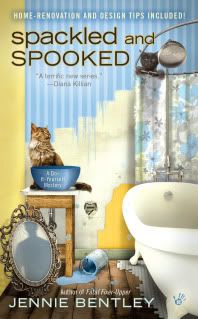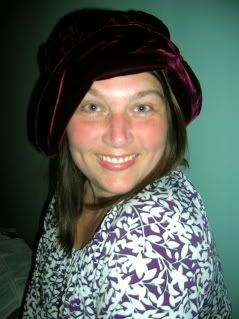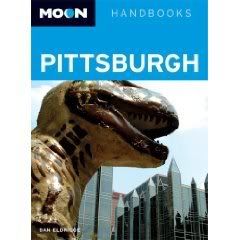Mystery writer Jennie Bentley, author of the acclaimed Do-It-Yourself Home Renovation mysteries from Berkley Prime Crime, speaks with Write On! about her experience in publishing, as well as her just-released book Spackled and Spooked. Her first in the series—Fatal Fixer-Upper—was released last November.

How did this book series come about?
I actually wrote a different book first. It’s called A Cutthroat Business, and will be released in June 2010. It is about a realtor who stumbles over a dead body in an empty house. The manuscript made it to an editor at Berkley Prime Crime, and although she didn’t feel it was right for them—they have a very narrow focus on what they call crafts and activities—she liked my writing. Once she realized that I have a background in real estate and renovation, she asked if I’d be interested in writing a series about a renovator for them. Something to take advantage of the interest in HGTV and Extreme Makeover: Home Edition. Something with tips for DIY projects, and maybe a hot handyman with tight jeans and power tools. I figured there were worse ways to break into publishing than what was then a three-book contract with Penguin, so I jumped at the chance.
What was your favorite part of writing Spackled and Spooked? The greatest challenge?
Spackled and Spooked was a pretty easy book to write, everything considered. Not that it’s ever easy to write any book, really, but I’ve certainly had a more difficult time with others. Fatal Fixer-Upper, the first in the series, was a horrible pain to get right. I had to completely rewrite it twice. By the time I started Spackled and Spooked, I’d gotten to know the characters and the setting and the whole set-up well enough to make for an easier time, besides which it’s a nicely linear, not too complicated story.
My biggest problem in writing anything fictional is usually plot, making the whole thing hang together and make sense, without giving away too much along the way. Part of the fun of reading a mystery—at least to me—is trying to figure out whodunnit before the revelation at the end, and to do that, there has to be enough information to be fair, but not so much that it gives the outcome away. It’s a fine balance, and one not always easy to achieve.
How did you get involved doing renovation?
My husband and I bought our first house in 2000. We were young and poor, so the house was small and cheap, and needed some updating. We were able to increase the value quite a lot just by making minor improvements. We sold it two years later at a nice profit, and bought another. And then we did it again. And again. By now, it’s been nine years, and we’re on our ninth house. … Old houses have so much character, such wonderful features, and it’s something like a calling, almost, to take a house that’s been neglected and abused and bring it back to vibrant life.
What was your experience getting you book(s) published?
I wrote the manuscript for A Cutthroat Business in about six months, and started querying agents with it. It took about four months and 40 queries (and some tweaking of the manuscript) before I had one. She started sending it to editors at publishing houses, and one of them offered me the opportunity to write the DIY-series. That was about six-months later. Fatal Fixer-Upper was released a year and a half after that, since I had to physically write it before the publishing process could start. Getting A Cutthroat Business signed for publication was a lot harder and more time consuming. We sent the manuscript to every publishing house we could think of, and everyone turned it down… until just before Christmas 2008, when it made it into the hands of the senior editor at a small independent publisher in New England. … The book will be published in June 2010.
What is the importance of mixing things (ideas, topics, genres: home renovation and murder) up when writing fiction?
As someone who writes a series, I have to keep certain things the same in all the books. Readers come to them expecting familiarity, and that’s what I have to deliver. At the same time, each book has to be different from the others, because no one likes to read the same story over and over again. My books are set up so that my main character Avery Baker and her sidekick, handyman Derek Ellis, renovate a different house in each book. There are fresh dead bodies in each, too, but there is also always a “history mystery,” a riddle from the past that is somehow connected to the current house or plot.
In a broader sense, too much mixing of things, especially genres, makes a manuscript a hard-sell. My genre is cozy mystery, which lately has come to be synonymous with cutesy, crafty mysteries about scrapbookers, knitters, petsitters, and bakers. The genre sells well, and for someone who wants to write in it, it’s important to stay within certain parameters.
The same thing goes for other genres, as well, of course. They’ve all got their guidelines, and for a reason. For most writers hoping to be published, writing within the lines is the best way to go. Cross-genre is hard to sell, because editors are going to have a hard time imagining where to market it. That said, it’s important to come up with a new twist on what is sought. For instance, there are tons of culinary mysteries out there in cozy-land, but culinary is a hot subject, so a fresh approach will likely work. Something like putting together culinary and pets into a dog bakery, for instance.
How much of your books are based on personal experiences? You know, other than the mystery part.
Hah! All the renovating and house-related stuff, I guess. I’ve wielded my fair share of hammers, sanders, and paint brushes. I spent a half dozen years living in New York City in my early twenties, and. although I wasn’t born there, like Avery, I can relate to her feelings of being stuck on the outer edge of the back-beyond once she gets to Maine. When I moved from New York to a much smaller place in the South, it took a long time for me to get used to the slower pace and the fact that I couldn’t have whatever I wanted, whenever I wanted.
Oh, and Derek looks quite a lot like my husband, too.
What factors specific to the mystery genre do writers need to know?
It’s good to keep up with what are the “in’ genres (within mystery) at any given time. For a while, while Janet Evanovich and Stephanie Plum were the hottest thing out there—not that they’re not hot right now—everyone wanted to write the next Stephanie Plum. The market got flooded with Stephanie Plum clones, and readers overdosed on the sassy heroine and the hot, mysterious love interest. These days, historical mysteries seem to be very popular, and there are a lot of historical series being picked up by publishing companies. Along with, of course, the ever popular thriller and romantic suspense.
That doesn’t mean you should sit down and write what is popular right now, though, because by the time you’re finished writing it, it may not be popular anymore.
Additional advice for writers?
Read a lot. Anything, really; not just the stuff in your genre. Good writing is good writing wherever you find it. And then write a lot. AIC—ass in chair—every day, or as often as you can manage. It may seem like some people are born with the ability to string words together in a way that’ll make you weep with joy, but writing is a craft, and as such can be learned, or at least developed. If you read a lot, syntax and flow and rhythm will just sort of seep into your brain without much conscious effort, and you’ll be a better writer for it. And that’s without actually analyzing what you read, which is very helpful if you’re able to do it. Picking it apart rather ruins the enjoyment of a good book, but it’s helpful in developing craft.
Secondly, learn as much as you can about the business of publishing. These days, even the most brilliant writer doesn’t stand a chance unless he or she knows how to play the game and can navigate the ins and outs of the process.
What do you know now that you wish you knew at the beginning of your career?
I wish I would have figured out much sooner how the business of writing and publishing works. I got my first rejection letter eight or nine years ago, at a time when I thought I might want to write romance novels, mainly because someone had told me it was “easy’ to get published in romance. (Break for cynical laughter here.) So I wrote a synopsis—not a book, just the synopsis—and sent it off to New York. A couple of weeks later, I received a two-page personalized letter from an editor at Harlequin outlining everything that was wrong with my “book” and detailing what she thought I might do to improve it. These days, I know that this is code for, “Fix this and send it back to me,” but then I hadn’t a clue, so I put it in a drawer and never looked at it again. I even stopped writing for several years after that, because I obviously didn’t have what it takes: I’d gotten rejected, and in a genre where it was “easy’ to get published! It’s galling to realize that if I’d known then what I know now, I might have gotten published years ago. It just goes to show the importance of doing research on the business you’re hoping to enter.

Tags: Author Q&A Berkley Prime Crime Debra Eckerling DIY Fatal Fixer-Upper Jennie Bentley Spackled andSpooked Write On!










Comments are closed.
Thanks for having me, Deb! This was fun!
[…] Bentley, Spackled and Spooked Barbara Ransom & Joel Harris, Smooshy Strawberries Blake Snyder, Save the Cat¬Æ! Series […]